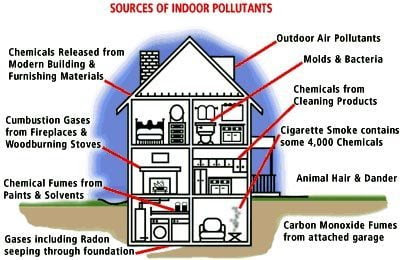Sick building syndrome (SBS) is a condition where building occupants experience a range of symptoms such as headache, fatigue, irritation of the eyes, nose, or throat, skin rash, and respiratory problems.
The exact causes of SBS are not well understood, but there are several factors that can contribute to its development, including:
- Poor indoor air quality: This is one of the most common causes of SBS. Factors that can affect indoor air quality include inadequate ventilation, chemical pollutants from building materials and furnishings, and biological contaminants such as bacteria, viruses, and molds.
- Chemical contaminants: Various chemicals used in building materials, such as formaldehyde, volatile organic compounds (VOCs), and radon gas can contribute to SBS.
- Inadequate temperature and humidity control: A poorly maintained HVAC system that does not provide adequate temperature and humidity control can lead to SBS.
- Poor lighting and glare: Inadequate or harsh lighting can cause eye strain and headaches, leading to SBS.
- Noise pollution: High levels of noise, such as from traffic or machinery, can cause stress and anxiety, leading to SBS.
- Psychological factors: Personal factors, such as stress, anxiety, and depression, can also contribute to SBS.
- Poor building design: Poor building design, such as the presence of tight spaces, poor lighting, or inadequate ventilation, can also contribute to SBS.
- Inadequate ventilation: When there is insufficient fresh air entering a building, pollutants can accumulate and cause poor IAQ. This can happen in buildings with sealed windows and doors or inadequate ventilation systems.
- Chemical pollutants: Chemicals found in cleaning products, building materials, and furnishings can release pollutants into the air, causing poor IAQ. Examples of these chemicals include formaldehyde, volatile organic compounds (VOCs), and particulate matter.
- Biological contaminants: Biological contaminants such as bacteria, viruses, and mold can grow and spread in buildings with poor ventilation and high humidity levels, leading to poor IAQ and potentially causing health problems.
The symptoms of poor Indoor Air Quality IAQ can range from minor discomfort to serious health problems such as respiratory diseases, heart disease, and cancer. Some common symptoms of poor IAQ include headaches, fatigue, nausea, dizziness, irritation of the eyes, nose, and throat, and respiratory problems such as coughing and wheezing.
To improve IAQ, building owners and managers can take several steps, such as ensuring adequate ventilation, using low-emission building materials and cleaning products, maintaining HVAC systems, and controlling humidity levels. Regular testing and monitoring of IAQ can also help identify and address potential problems before they become serious.
It is important to note that SBS is a complex condition, and it is often caused by a combination of factors. Identifying and addressing the underlying causes is important in mitigating and preventing the symptoms of SBS.

